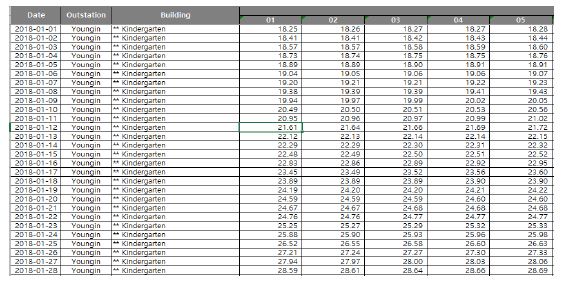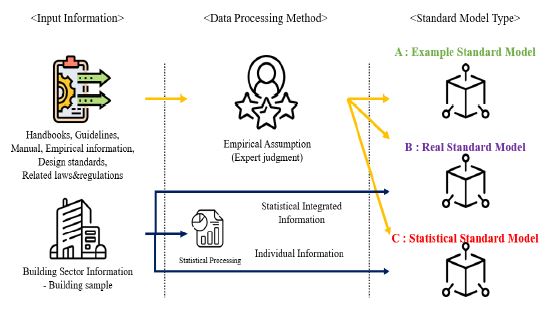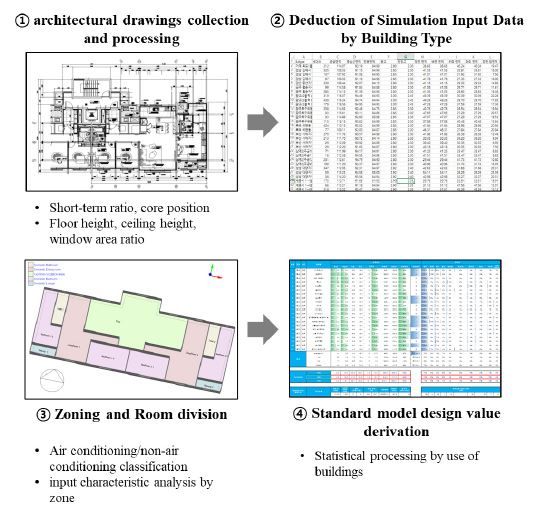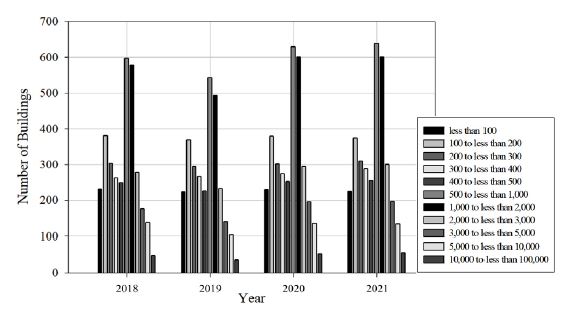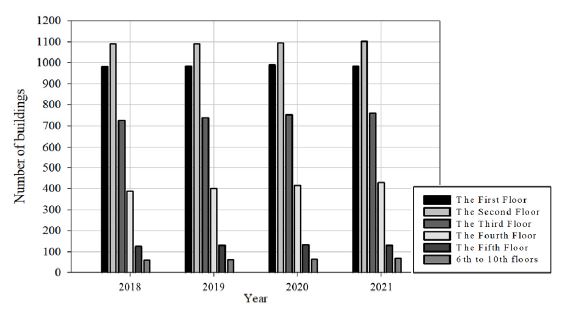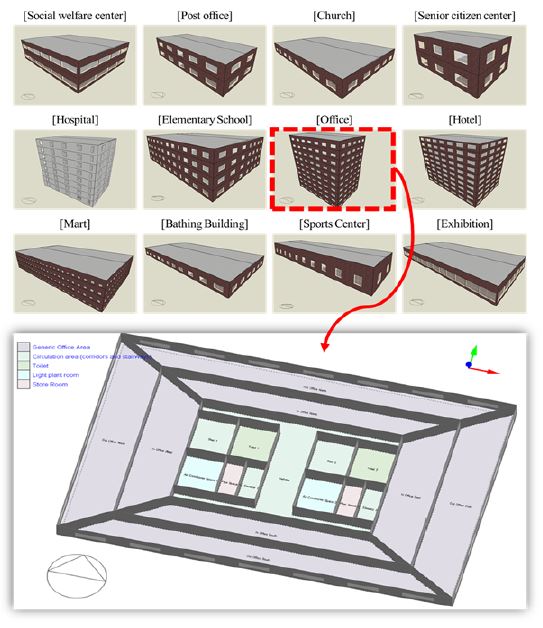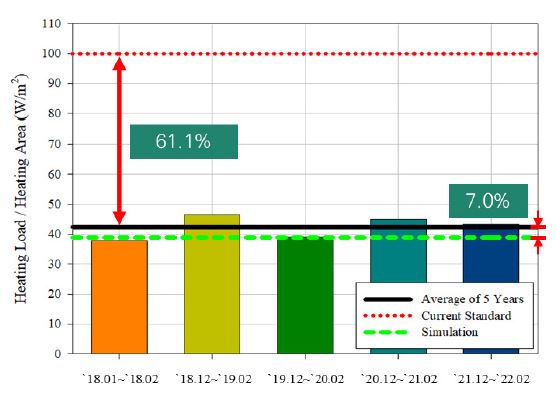
Analysis of the Appropriateness of Unit Heating Loads for Non-residential Buildings : Development of Reference Model by Application and Analysis of Quantity of Heat Data for District Heating
ⓒ 2022. KIEAE all rights reserved.
Abstract
The unit heating load standard is divided into multi-family housing and non-residential buildings. The detailed standards for multi-family housing were revised in November 2017; however, non-residential building standards have remained unchanged for 17 years since January 2006. This study aims to develop a standard model for non-residential buildings and analyzes the data regarding district heating usage, because a new standard for selecting the equipment capacity of buildings is needed according to the changes in the national energy saving policies and building insulation standards.
Based on the collection of drawings and statistical data for the investigation of the window area ratio and the ratio by reality, the optimal standard model for each purpose was developed. Based on the heat usage data of 121 buildings, comparisons and verifications were performed considering the simulation results and heat usage data.
The average load reduction rate of the amendment compared to the existing criteria for each of the 12 uses was analyzed to be 46.4%. Based on the heat usage data of 121 buildings, the average difference between the simulation result-based proposal and the error rate analysis was 10.8% for 12 different uses.
Keywords:
Unit Heating Load, Reference Building, Design Criteria for District Heating Facility키워드:
단위난방부하, 표준모델개발, 열사용시설기준1. Introduction
1.1. Background and Objectives
Efforts for reducing greenhouse gas emissions and energy consumption are increasing globally. To reduce the energy consumption in the building sector at a national level, the South Korean government promotes a policy for improving the insulation/airtightness performance; based on renewable energy sources,such as geothermal heat and solar power, the government has emphasized on implementing the zero-energy building (ZEB) dissemination policy.
As one of the policies for saving and efficiently utilizing energy, the insulation standard of buildings has evolved from the application of a single, uniform standard to a division into three regions in 2001. In terms of thermal transmittance (U-value), the standard became more stringent by 64% for external walls and 62% for doors and windows in 2022 compared to the levels in 2003. The application of the standard is classified into four regions (central region 1, central region 2, southern region, and Jeju region)[1]. As a result, the energy consumption for cooling and heating the indoor space of buildings has also been decreasing, in addition to the equipment capacity.
In the field of mechanical equipment design, load calculation methods for determining the building equipment capacity are mainly divided into the following two types: a precise calculation method through a load calculation program (simulation programs, such as RTS-SAREK, and EnergyPlus) and a rule-of-thumb method that derives the equipment capacity by multiplying the unit load by the air-conditioning area[2].
The Design Criteria for the District Heating Facility of the Korea District Heating Corporation (KDHC) recommends that non-residential buildings in areas subject to a mandatory district heating notice should refer to Table 1. to select equipment, which is used as a criterion for review in the district heating supply permission process[3].
The national policy of mandating the ZEB certification has been phased according to the roadmap;certification standards include the energy independence rate and a building energy efficiency of grade 1++ or higher. The detailed standards for the energy independence rate are outlined in Table 2., whereas those for a building energy efficiency of grade 1++ or higher are presented in Table 3.
The primary energy consumption per unit area (kWh/m2·year) required for the certification of a building according to the phased implementation plan of the policy is obtained by applying the primary energy factor to the energy consumption per unit area; this value is derived as a sum of the energy requirements for heating/cooling/hot water supply/lighting/ventilation. Through the quantity of heat data for district heating, the energy statistics for heating and hot water supply of different building are significant to be utilized as reference for review during building design. In addition, the unit heating load used for the calculation of the equipment capacity of a building with the supply of integrated energy requires a new standard derived based on the most-up-to-date legislative standards that are reflected in the design of new buildings.
Accordingly, the purpose of this study is to analyze the trend of energy consumption per unit area used for heating and hot water supply by building use, for which a quantitative evaluation can be derived using the district heating data for 5 years from 2018 to 2022. The unit heating load standard proposed in this study is also validated to evaluate its adequacy through the development of reference models, considering the trend of the latest building shapes.
1.2. Methods and Scope of Study
In this study, energy requirements of different non-residential buildings were analyzed, and reference models were developed for the estimation of the unit heating load, followed by a comparative analysis between the simulation results and actual usage data. The details and methods of the study are described as follows.
1) Laws and regulations related to the U-values of external and internal walls, and fresh-air inflow requirements related to the thermal load of non-residential buildings were investigated. Based on the collected drawings for the investigation of the window/wall area ratio and space size ratio of recently-built buildings (buildings that acquired planning permission after 2018) and statistical data, a reference model for each building use was developed.
2) Based on the reference models, the unit heating load was calculated using the DesignBuilder simulation software;the quantity of heat data (5 to 15 buildings for each use) of 121 buildings for the last 5 years received through KDHC were used to perform a comparative evaluation between the simulation results (based on the proposed standard of this study) and the actual quantity of heat data. The DesignBuilder program performs a dynamic simulation based on the American Society of Heating, Refrigerating,and Air-Conditioning Engineers (ASHRAE) 90.1 standard and is a globally recognized calculation tool based on the EnergyPlus program.
3) In addition to deriving the unit heating load by using the telemetering data for the quantity of heat, annual energy requirements were calculated to analyze the energy consumption for heating and the hot water supply for each building use.
2. Literature review and analysis of related standards
2.1. Analysis of annual energy requirement
Among the studies that performed energy consumption analyses for heating, cooling, hot water supply, lighting, and ventilation through measured data, the results for multi-family housing demonstrated that the energy usage was 70.0kWh/㎡·year for heating, 28.7kWh/㎡·year for hot water supply, 6.1kWh/㎡·year for lighting, and less than 2.0kWh/㎡·year for cooling and ventilation[4]. In a previous study regarding office facilities, the energy consumption was 59.7kWh/㎡·year for heating, 28.8kWh/㎡·year for cooling, 15.8kWh/㎡·year for lighting, and less than 4.8kWh/㎡·year for ventilation and hot water supply[5].
Because it is practically difficult to acquire the energy consumption data of many different buildings, previous studies have been mainly limited to multi-family housing and office facilities. To overcome these limitations, in this study, analyses of the energy requirements for non-residential buildings with 12 different uses were performed for a quantitative evaluation of the energy requirements by use and their rankings.
2.2. Analysis of unit load
Because selecting the facility equipment capacity of buildings is based on the unit load standard for the integrated energy supply permission, active research has been conducted to examine the adequacy of the standard.
Previous studies regarding unit loads with various approaches are introduced as follows. For establishing methods for the energy performance evaluation of multi-family housing in the early stage of design, simulations were performed using EnergyPlus with changes in the window/wall area ratio, U-values, and solar heat gain coefficients for doors and windows in the building envelope, which are key design elements; a formula for calculating the unit cooling and heating loads was presented by using regression equations. The results demonstrated that the error rate between the simulation and calculation results was 5.6% and 1.2% at maximum, respectively[6]. In addition, for the re-estimation of the unit cooling load of buildings, a reference model of a non-residential building was developed, and the simulation results and quantity of the heat data were compared to derive causes of oversizing and improvement measures. The results demonstrated that compared to the value of the unit cooling load based on the Design Criteria for District Heating Facility in 2003, when the 2019 Building Energy Code was applied, the unit cooling load was reduced by approximately 19.9%. Based on the newly derived method for calculating the unit cooling load, the value for the office facility was 120W/㎡, 62W/㎡ for officetel (a type of multi-purpose building with residential and commercial units in South Korea), 138W/㎡ for a retail facility, 124W/㎡ for a neighborhood living facility, 107W/㎡ for an educational research facility, 82W/㎡ for an accommodation facility, 197W/㎡ for a department store, and 227W/㎡ for broadcasting facilities[1][7]. In addition, based on the current status of domestic buildings and literature, reference models for residential and office facilities were developed, and unit cooling and heating loads were derived considering the temperature, humidity, sensible heat/latent heat, ventilation, and radiant heating using a Simulation Program for Heat Load (Sim-Heat). For residential facilities, when the insulation condition became more stringent by 10%, 30%, and 50%, the unit heating load decreased from 38W/m²to 36, 29, and 18W/m2, respectively; for office facilities, the unit heating load decreased from 87W/m²to 81, 73, and 68W/m2, respectively[8].
In domestic weather conditions, the cooling load is generally larger than the heating load; thus, when selecting the building equipment capacity, the peak load is derived based on the cooling load, and the facility equipment is selected based on the derived value. Accordingly, more studies were conducted for the standard of the unit cooling load compared to the standard for the unit heating load. Therefore, this study focused on deriving an adequate unit heating load standard to promote the dissemination of district heating, which is important in the supply of integrated energy.
2.3. Reference model development
In the field of building energy, reference models are used for relatively simple predictions of the load, an important criterion for determining the facility equipment capacity, and is also used as a reference for a comparative analysis of the energy consumption according to the facility system.
In a previous study using a reference model to evaluate the adequacy of the load and energy consumption calculations, school buildings were classified into seven different shapes (E, H, L, O, U, rectangular shape, and complex shape), the impact of the detailed exterior appearance, operational method, and weather conditions were analyzed for each shape of the building to develop a reference model for deriving the energy consumption per unit area. In the study, cross-validation was performed using the district heating quantity of heat data, and quantitative results were derived to obtain the basic data for benchmarking when designing school buildings[9]. In another study, based on the data of 230 office buildings built in India in the last 10 years, reference model development was investigated. Reference models were developed through a statistical analysis of the insulation standards of the total floor area, air-conditioning area, window/wall area ratio, number of floors, floor height, and envelope of buildings. Subsequently, reference data were presented by deriving the unit load and annual energy consumption in various climates of India, which can be utilized for standards on the Energy Performance Index (EPI)[10]. In another previous study, based on 120 houses built in Brazil, reference models were developed for the analysis of the thermal and energy performance characteristics based on the total floor area, ratio of the space area for the living room, kitchen, and toilet, and the aspect ratio of the buildings[11].
For the development of reference models for individual uses, such as schools, office buildings, and houses, studies regarding various approaches were conducted similar to the previous studies indicated above; however, studies regarding the development of reference models for other uses and research in this field is limited in South Korea in comparison to other countries, resulting in evaluation reports and standards based on weather conditions of overseas countries. Thus, in this study, we developed reference models based on weather conditions in South Korea and quantified heat data by building use.
2.4. Design Criteria for District Heating Facility
Among domestic non-residential buildings, a heat source design using district heating and cooling is mandated for buildings subject to the Integrated Energy Supply Act (Act No. 15022)[12], and the detailed criteria for the related facilities are specified in the Design Criteria for District Heating Facility. These criteria were enacted in June 1990; in Article 8, the relevant criteria are presented under the heading of the calculation criteria for heating/hot water supply and cooling loads. The unit heating load is presented by categorizing multi-family housing and non-residential buildings. For multi-family housing, the detailed criteria were revised in November 2017 since the enactment; however, for non-residential buildings, it has remained unchanged for 17 years since January 2006.
Therefore, studies are required for a revised unit heating load through reference models that reflect the government's policy direction for reduced energy consumption and the shapes of recently-built buildings, and the appropriate amount of heat from the primary side to the secondary side needs to be calculated in the checking and reviewing stage for the district heating supply.
3. Energy consumption analysis of non-residential buildings and adequacy evaluation of the unit heating load
3.1. Construction of analysis datasets
To perform an analysis of the energy requirements and an evaluation of the unit heating load adequacy of non-residential buildings using district heating as a heat source, we comparatively analyzed the quantity of heat data supplied to buildings of various uses provided by KDHC. Fig. 1. presents a data format for quantifying heat, in which the dates are recorded in rows,and values for the hourly quantity of heat for the cumulative primary side are recorded in columns (Gcal/h).
3.2. Development of reference model
The system of building uses of non-residential buildings for constructing the reference models was established based on the classification specified in KDHC’s Design Criteria for the District Heating Facility. There are a range of detailed uses within the classified use, and the detailed uses were set based on the district heating supply status by each KDHC building provided by the Ministry of the Interior and Safety[13]; the building with the largest number of permissions was set as the representative use. This is summarized and shown in Table 5.
As of 2021, 67 of the 2,559 non-residential buildings with a district heating supply were neighborhood living facilities, among which social welfare centers accounted for the majority (29); thus, this use is set as the representative source of use. Out of 173 neighborhood public facilities, there were 14 post offices, out of 55 religious facilities, there were 37 churches, and 139 kindergartens (daycare centers) out of 147 senior and child facilities were identified. There were 114 elementary schools out of 246 educational research facilities, 62 hotels out of 76 accommodation facilities, 56 supermarkets out of 64 retail facilities, 20 public bath out of 21 amusement facilities, and 17 sports centers out of 59 viewing and assembly facilities. Thus, each type was set as a representative detailed use of these non-residential buildings.
Furthermore, the facilities utilized in the development of the reference model but did not have detailed uses in the classification of buildings were as follows: 53 medical facilities, 1,651 office facilities, and 12 exhibition facilities.
The development of reference models was conducted by selecting the building with the largest number of detailed uses. Methods of the reference model development can be classified into three types, as shown in Fig. 2.[14]. Among the modeling methods, the example reference model (A) is used in a situation where the samples or data are unavailable; all the information from the shape of the building to the internal input factors is entered based on empirical decisions of experts. This method has a drawback considering that the generalization of the results for the multitude of buildings is difficult owing to the reflection of the subjective opinions of experts. For the real reference model (B), when the number of available samples or data is insufficient, only the internal input factors are processed using statistics based on the most common cases among the samples. Depending on the samples collected, the characteristics of the result may vary. The last method, statistical reference model (C), can be used when the number of available samples is sufficient, and the results are obtained through a statistical analysis from the architectural shape and size of the sample buildings to the internal input factors. This is a highly reliable method presenting the most apparent basis for generalization; however, securing a sufficient number of samples is usually difficult.
In this study, the statistical reference model (C) was applied as the top priority methodology, and the real reference model (B) was used when the number of available samples was insufficient. Specifically, the reference models were developed by applying a statistical reference model (C) when the number of samples for each use was more than 20; the real reference model (plan B) was applied when there were less than 20 sample cases for individual uses.
Table 6. outlines the number of buildings collected for the reference model development through design documentation by building use. The data required for calculating the heating load are as follows: architecture-related design documentation (aerial view, architectural outline, performance details by type, plot plan, floor plan, sectional drawing, elevation drawing, doors and windows schedule), mechanical equipment documentation (equipment list, utility distribution) diagram, mechanical equipment calculation, etc.), and electrical equipment related documentation (lighting equipment list, lighting diagram, lighting power density calculation).
Data construction based on the collected design documentation was conducted according to the procedure shown in Fig. 3. For generalization of the floor plan, physical information, such as the floor height, window/wall area ratio, space area ratio by room of each building, was statistically processed. Becausethere is a large difference in the minimum and maximum values for each building, median rather than mean values were used and applied to the reference model. In particular, for factors, such as the window/wall area ratio that has a significant impact on the solar heat gain and U-value, information determined through several design cases was collected to enable the shape of the reference model to properly represent the corresponding building type accordingly.
3.3. Review and analysis of the laws and regulations related to design elements of heating load
The architectural design must meet the standards stipulated by the Building Act. There are approximately 40 laws related to the design process and 13 laws related to the heating & cooling loads of buildings. Representative regulations include the Building Energy Code, Regulations on Support for New and Renewable Energy Facilities, Rules on Facilities Standards for Buildings, and the Integrated Energy Supply Act. The design temperature, U-value, and frequency of ventilation, which are the design criteria necessary for calculating the heating load, were derived and set as the reference model dataset.
For the development of reference models considering the size and shape of buildings, the total floor area and number of floors were determined based on the size data and number of floors by use presented in the Building Life Cycle Management System provided by the Ministry of Land, Infrastructure and Transport (MOLIT) in 2021[15]. As shown in Fig. 3., for a social welfare center of the neighborhood living facility, the buildings with a total floor area ranging between 500-1000m2 were collected with the largest number at 639 (18.9%), and those with two floors were collected with the largest number at 1,103 (31.7%). The typical floor area using this information was derived by dividing the total floor area by the number of floors and the value of 350 m2 was applied. In addition, the typical floor area and number of floors for each building use are shown in Table 7.
3.4. Modeling of non-residential buildings by building use
DesignBuilder was used for modeling the 12 reference models derived, as shown in Fig. 5. For the design elements for heating by building use, the values shown in Table 8. were applied according to the relevant laws that were reviewed in the previous section. Weather data provided by Climate.OneBuilding.Org[16] was set for the 12 building uses. The 5-year average data in 11 regions were used, including Seoul, Daejeon, Daegu, and Busan, to derive the heating load. For the minimum fresh air requirements, according to the Rules on Facilities Standards for Buildings presented by MOLIT[17], the required amount of fresh air for each building use was applied. For indoor heating temperatures and U-values of the external wall, roof, floor, and windows & doors, the values of central regions 1 and 2, and the southern region in the "Building U-value Table by region" from the Building Energy Code[18] presented by MOLIT, were used for application. Indoor loads, such as the human body load, equipment load, and lighting load, were not considered in the reference model application because they are not reflected in the heating load calculation.
3.5. Analysis of energy requirements by building use
The energy requirements for district heating are analyzed and presented in Table 9. The values of energy requirements for the heating of non-residential buildings with twelve different uses are as follows: Neighborhood living facility (81.4kWh/㎡·year), neighborhood public facility (40.1kWh/㎡·year), religious facility (30.7kWh/㎡·year), senior and child facility (104.6kWh/㎡·year), medical facility (97.4kWh/㎡·year), educational research facility (20.5kWh/㎡·year), office facility (58.7kWh/㎡·year), accommodation facility (114.6kWh/㎡·year), retail facility (70.0kWh/㎡·year), amusement facility (367.7kWh/㎡·year), viewing and assembly facility (213.1kWh/㎡·year), and exhibition facility (32.5kWh/㎡·year).
The average energy requirement of 12 non-residential buildings was 102.6kWh/㎡·year. The analysis demonstrated that the building uses with the largest values of energy requirement were in the order of amusement, viewing and assembly, and accommodation facilities, whereas the building uses with the smallest values of energy requirement were in the order of educational research, religious, and exhibition facilities.
3.6. Proposed unit heating loads and verification of data
For a validation of the simulation results of the reference models that reflected the unit heating load according to the Design Criteria for the District Heating Facility and the up-to-date Korean Design Standard and evaluation of the adequacy, a comparative analysis was performed considering the quantity of heat data for the various building usages. By analyzing the primary side quantity of heat, there was a limit in deriving the energy consumption with the secondary side heating and hot water supply separated; thus the load was calculated by applying the ratio of heating and hot water supply by building use derived from previous studies[4][5].
Changes in building operation schedules due to the COVID-19 pandemic may have a significant impact in this study, which aims to present a revised standard. As a result of examining the pandemic effect, the energy consumption used in buildings decreased by approximately 10 to 15%; however, in terms of peak load, there was a difference ranging between 4 - 8%. Considering the major factors for calculating the heating load, the indoor heating load was excluded to adjust for the COVID-19 pandemic effect; thus, the impact was not applied to the results of this study.
As shown in Fig. 7., as a result of the simulation of a neighborhood living facility, the unit heating load value was 63.2W/m2, which presents a difference of 36.8% compared to the value of the Design Criteria for the District Heating Facility established in 2006. The quantity of heat for 10 social welfare center buildings was 65.5W/m2, demonstrating a difference of 3.2% compared to the criteria value.
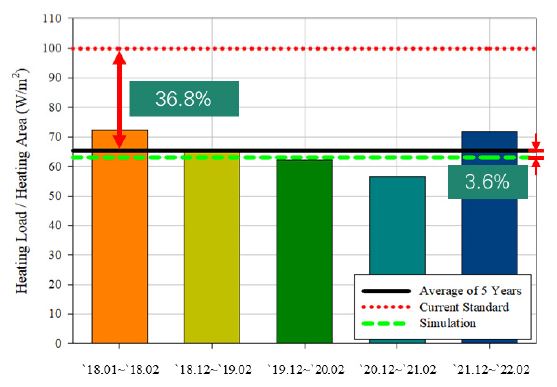
Comparison of social welfare center simulation results with actual heating usage over 5 years and standard
As shown in Fig. 8., the proposed unit heating load value of the educational research facility is 58.5W/m2, demonstrating a difference of 43.5% compared to the value of the Design Criteria for the District Heating Facility. The quantity of heat data from 2016, which occurred before the COVID-19 pandemic, from 10 elementary schools was analyzed while considering the ‘Covid-19-related Guidelines in Education’. The heating load decreased by an average of 10.26% from 2020 to 2021; however, considering the peak load calculation, the value decreased from 66.8W/m2 (January 2016 to February 2018) to 61.3W/m2 (December 2018 to February 2022), demonstrating a difference of 8.2%. During the entire period, the unit heating load for the peak value was analyzed to be 63.7W/m2, which is a difference of 8.2% compared to the criteria value presented.
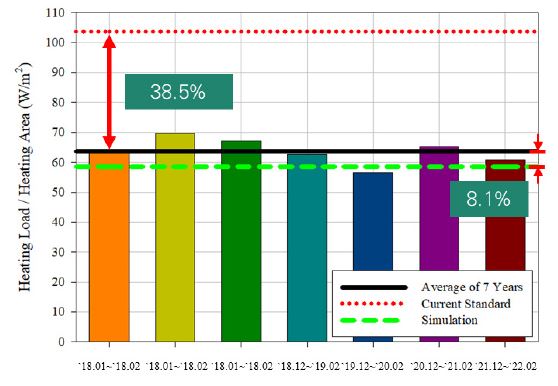
Comparison of elementary school simulation results with actual heating usage over 7 years and standard
As shown in Fig. 9., the proposed unit heating load value of the office facility is 39.0 W/m2, demonstrating a difference of 61.1% compared to the value of the Design Criteria for the District Heating Facility. The quantity of heat for 10 office facility buildings was 41.9W/m2, demonstrating a difference of 7.0% compared to the value based on the criteria. The unit heating load values for other buildings are presented in Table 10.
As shown in Table 10., to investigate the difference between the simulation results and the quantity of heat data, the values were set as A and B, respectively; the error rate was calculated and shown for each building use.
Compared to the simulation results of 12 buildings and the unit heating load based on the Design Criteria for District Heating Facility, the average rate of reduction is approximately 47.2%. This indicates that there is considerable difference between the unit heating load based on the current criteria and the newly calculated unit heating load that reflected the revised insulation standard, which is in line with the national energy consumption reduction policy and the trend of recently-built buildings.
If the proposed criteria can be applied, owing to the decrease in the equipment capacity, a reduction in the initial investment cost for constructing a new building and an improved efficiency in the energy consumption for partial operation can be expected.
When comparing the simulation results and quantity of heat data, an average error rate of approximately 10.8% occurred. The building use with the lowest error rate was 1.6% for marts, and the highest error rate was at 24.1% for the senior and child facilities. Because reference models were established and the simulation result was presented based on the revised standard (plan), despite considering the basic error rate occurring compared to the quantity of heat of individual buildings, the error rate is significantly large. This large error rate is analyzed for the senior and child facility, where kindergarten (daycare) was set as the detailed source of building use; however, the continuous increase in the number of dual-income couples and the variability of operating hours due to volatile operating schedules can cause the large difference. For large-scale facilities, such as churches, to maintain the indoor temperature at a constant level, an electric heating system, such as an electric heat pump (EHP) or gas heat pump (GHP), was unofficially added for use, as well as the heat supply from the district. These factors are considered to be the main reasons contributing to the simulation error rate.
4. Conclusion
In this study, although the adequacy of the design documentation samples for each building usage has limitations in representing all the buildings nationwide, the results derived through the simulations were evaluated with the quantity of heat data. To establish reference models for a re-estimation of the unit heating load and to revise the standard, the quantity of heat usage of 121 buildings for the last 5 years and DesignBuilder simulation results were compared and analyzed for 12 types of building usage.
- ㆍAs a result of the energy requirement analysis based on building usage, the mean value of 12 non-residential buildings was 102.6kWh/㎡·year.
- ㆍThe amusement and educational research facilities had the highest and lowest values of energy requirements at 367.7kWh/㎡·year and 20.5kWh/㎡·year, respectively.
- ㆍThe average load reduction rate of the revised standard compared to the existing standard for 12 types of building usage was 47.2%.
- ㆍBased on the quantity of heat data of 121 buildings, an average difference of 12.9% for 12 different types of building uses was shown in the analysis of the error rate compared to the proposed values based on the simulation results.
- ㆍFurther studies are required to reduce the gap between the unit heating load based on the current standard and the unit heating load that reflected the revised insulation standard in line with the national energy consumption reduction policy and the trends of recently-built buildings, as well as for a comparison between the quantity of heat data and actual heat usage data.
- ㆍThrough the proposed revision of the unit heating load, the selection of equipment capacity can be optimized, thereby reducing the initial investment cost for constructing new buildings and improving the energy consumption efficiency for partial operations.
Acknowledgments
This study was conducted as part of a research project funded by the Korea District Heating Corporation (Grant No: 1003542021S131). We acknowledge the support from their employees associated with the Carbon Neutrality Division, as well as the team members of the Research Institute, WooWon M&E Inc., and our CEO.
References
-
박두용 외 3인, 일반건축물 단위냉방부하 선정을 위한 용도별 표준모델 구축에 관한 연구, 설비공학논문집, 제31권 제8호, 2019.08, pp.370-379.
D.Y. Park et al., A Study on the reference building model for the selection of unit cooling loads for non-residential buildings, Korea: Korean Journal of Air-Conditioning and Refrigeration Engineering, 31(8), 2019.08, pp.370-379. [ https://doi.org/10.6110/KJACR.2019.31.8.370 ]
-
황동곤, 비주거용 건물 유형별 표준모델과 단위부하 개선에 관한 연구, 한국: 서울시립대학교 박사학위논문, 2020, pp.10-11.
D.G. Hwang, A study on the reference building model and unit load improvement for various non-residential buildings, Korea: University of Seoul Doctoral Thesis, 2020, pp.10-11. -
한국지역난방공사, 열사용시설기준, 2020.4.29.
Korea District Heating corporation, Thermal Use Facility Standard, 2020.4.29. -
진혜선 외 5인, 표본건물 계측에 의한 공동주택 세대에서의 용도별 에너지사용량 및 CO2 배출량 연간 원단위 (2016 – 2017) 분석, 대한건축학회 논문집, 제34권 7호, 43-52pp, 2018.07
H.S Jin et al, Annual intensities (2016–2017) analysis of energy use and CO₂ emission by end use based on measurements of sample apartment units, A Collection of Papers of the Korean Society of Architecture, 34(7), 2018.07, 43-52pp -
임한영 외 6인, 표본건물 계측에 의한 업무시설에서의 용도별 에너지사용량 및 CO2 배출량 연간 원단위 (2016 – 2017) 분석, 대한건축학회 논문집, 제34권 8호, 19-27pp, 2018.08
H.Y Lim et al, Annual intensities (2016-2017) analysis of energy use and CO₂ emission by end use based on measurements of sample office building, A Collection of Papers of the Korean Society of Architecture, 34(8), 2018.08, 19-27pp -
한세희 외 3인, 발코니 창호 요소 변화에 따른 아파트 단위세대 냉난방부하 산출모델 제시, 한국: 한국건축학회지회논문집, 제6권 제4호, 2012.10, pp.199-205
S.H Han et al., Propose on the calculation model of balcony window configuration on annual heating and cooling load of residential apartments, Korea: Dec of KIAEBS, 6(4), 2012.10, pp.199-205. -
박두용, 최슬건, 일반건물 용도별 단위냉방 실사용량과 시뮬레이션 비교분석을 통한 과설계 원인 분석 및 개선방안 도출, 한국: 한국생태환경건축학회 논문집, 제19권 제1호, 2019.10 pp.87-92.
D.Y. Park, S.G. Choi, Analysis of oversizing causes and improvement plans through comparative analysis of cooling actual energy and eenrgy simulation by general building types, Korea: Korean Institute of Architectural Sustainable Environment and Buildings Systems, 19(1), 2019.10, pp.87-92. [ https://doi.org/10.12813/kieae.2019.19.5.087 ]
-
이준호, 김현우, 윤성환, 건물 설계변수에 따른 단위열부하 산정에 관한 연구, 한국: 대한건축학회연합논문집, 제15권 제4호, 2013.08 pp.109-114.
J.H. Lee, H.W. Kim, S.H. Yoon, Study on evaluation of unit thermal load by building design parameters, Korea: The Regional Association of Architectural Institute of Korea, 15(4), 2013.08, pp.109-114. -
M.S. Geraldi et al., Evaluating the impact of the shape of school reference buildings on bottom-up energy benchmarking, Brazil: Journal of Building Engineering, 2021, pp.333-356.
[https://doi.org/10.1016/j.jobe.2021.103142]

-
M. Bhatnagar, J. Mathur, V. Garg, Development of reference building models for India, India: Journal of Building Engineering, 2018, pp.267-277.
[https://doi.org/10.1016/j.jobe.2018.10.027]

-
A. Schaefer, E. Ghisi, Method for obtaining reference buildings, Energy and Buildings, 22016, pp.660-672.
[https://doi.org/10.1016/j.enbuild.2016.07.001]

-
집단에너지사업법, 법률 제15022호, 2017.10.31.
Group Energy Enterprise Law, No 15022, 2017.10.31. -
행정안전부, 한국지역난방공사 건물별 지역난방 공급현황 정보, 2021.
Ministry of Public Administration and Security, Information on the District Heating Supply Status by Building of Korea District Heating Corporation, 2021. -
Corgnati, S.P., Fabrizio E., Filippi, M., and Monetti, V., 2013, Referenece buildings for cost optimal analysis : Method of definition and application, Applied Energy, Vol. 102, pp. 989-993.
[https://doi.org/10.1016/j.apenergy.2012.06.001]

-
국토교통부, 건축물생애이력관리시스템, 2022.
The Ministry of Land, Infrastructure and Transport, Building Life History Management System, 2022. - Climate.OneBuilding.Org, Repository of free climate data for building performance simulation, From the Creators of the EPW, South Korea Data, 2022.
-
국토교통부, 건축물의 설비기준 등에 관한 규칙, 2021.8.27.
The Ministry of Land, Rules on Facilities Standards for Buildings, etc., 2021.8.27. -
국토교통부, 건축물의 에너지절약설계기준, 2022.7.29.
The Ministry of Land, Energy Saving Design Standards for Buildings, 2022.7.29.

